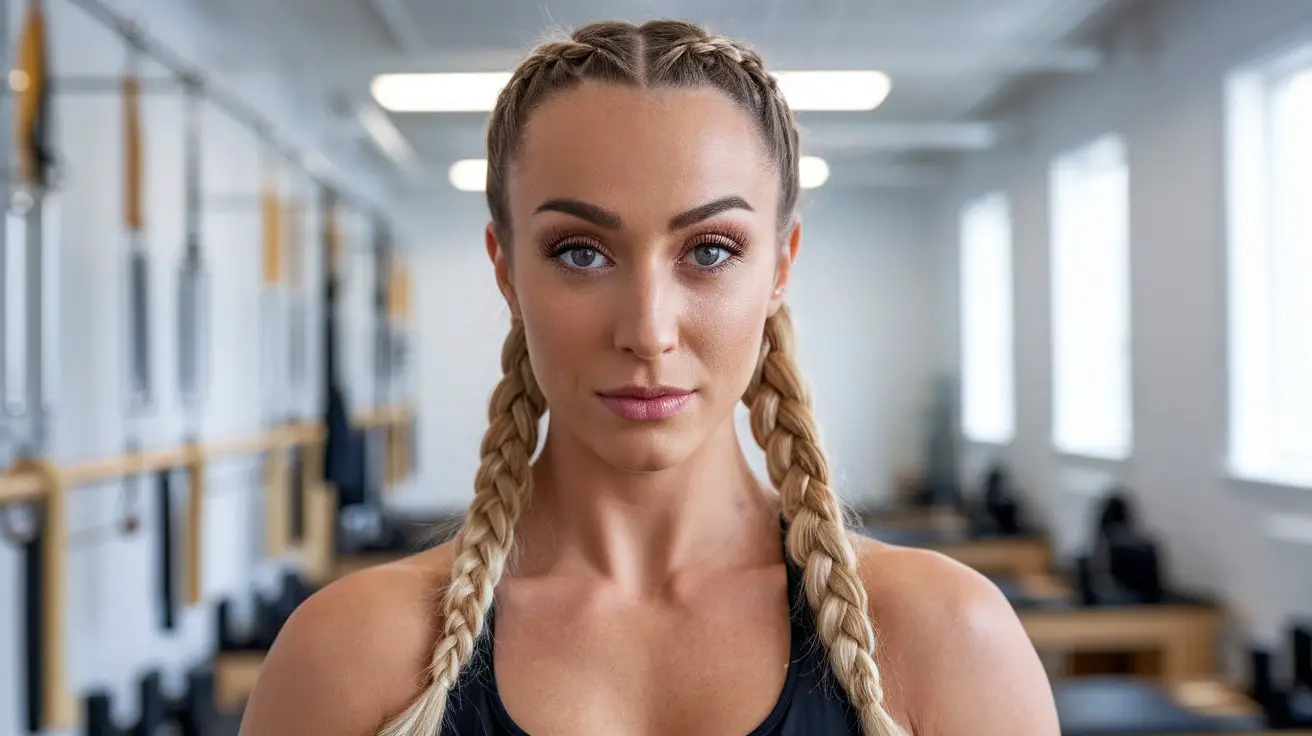Finding the right hairstyle for Pilates can make a significant difference in your workout experience. Many women struggle with hair falling in their face, getting tangled during movements, or causing discomfort when lying on the mat. A proper hairstyle not only keeps you comfortable but also helps you maintain focus on your exercises without constant adjustments.
The specific movements in Pilates create unique challenges for hair management. Rolling exercises, inversions, and transitions between positions can quickly turn a neat hairstyle into a mess. Traditional workout hairstyles often fall short during Pilates sessions, as they don’t account for the constant contact between your head and the mat or the flowing nature of the movements.
The following sections will share practical hairstyling solutions specifically designed for Pilates practice. From secure styling techniques to the best hair accessories, you’ll discover how to keep your hair perfectly in place throughout your entire session. Let’s explore these Pilates-friendly hairstyles that combine both function and style.
- Why Do Regular Workout Hairstyles Not Work for Pilates?
- What Are the Most Comfortable Pilates Hairstyle Options?
- How Should You Adapt Your Hairstyle for Different Pilates Exercises?
- Which Hair Accessories Work Best for Pilates?
- How Can You Maintain Your Hairstyle Throughout Your Pilates Session?
- Perfect Hair, Perfect Practice
- Frequently Asked Questions
Why Do Regular Workout Hairstyles Not Work for Pilates?
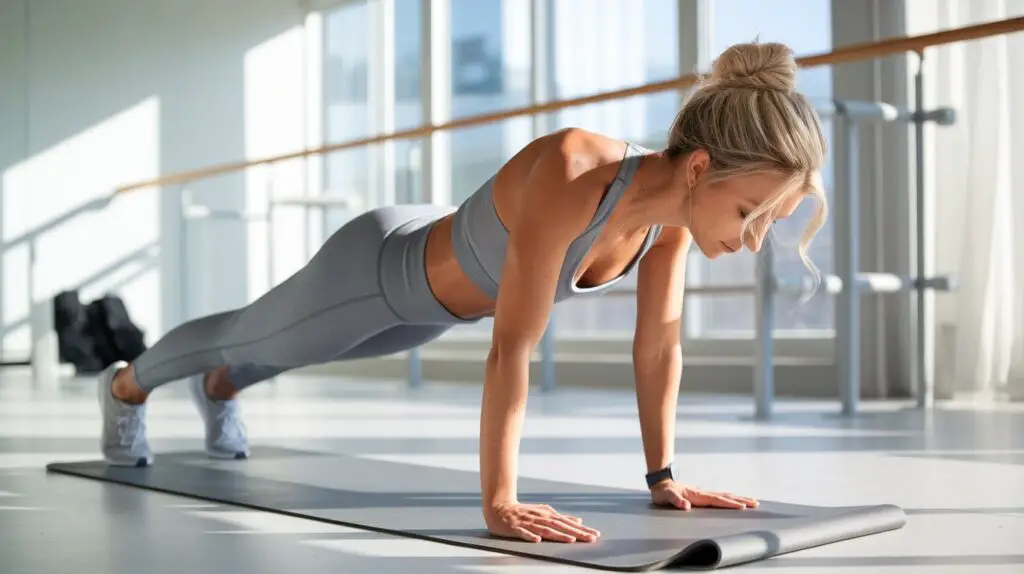
Regular workout hairstyles might work well for running or weightlifting, but Pilates presents specific hair management challenges. The constant movement between positions and the frequent contact with the mat can turn your standard gym hairdo into a major distraction.
The Unique Movements in Pilates That Affect Hairstyling
Pilates involves fluid movements that require your body to transition smoothly between positions. These continuous changes create specific problems for your hair. A style that works perfectly for standing exercises might become uncomfortable during floor work. The rolling motions and controlled movements in Pilates demand a hairstyle that stays secure from multiple angles.
Many women notice these common hair-related issues during their Pilates sessions:
- Hair getting caught under shoulders during roll-ups
- Strands falling into eyes during plank positions
- Tangles forming during spiral movements
- Knots developing from mat friction
- Scalp discomfort from poorly placed hair ties
Problems with Traditional High Ponytails
The classic high ponytail, while popular in many workouts, creates several issues during Pilates exercises. The height of the ponytail can press uncomfortably against your head during supine positions, forcing your neck into an awkward angle. This misalignment defeats the purpose of precise Pilates movements.
The swinging motion of a high ponytail also becomes problematic during controlled exercises. Your hair can whip around during transitions, hitting your face or getting in the way of your vision.
Issues When Lying on Your Back
Back exercises form a crucial part of Pilates routines, but they present unique hair challenges. A poorly positioned hairstyle can create pressure points on your scalp, leading to discomfort and distraction during essential movements.
The friction between your hair and the mat can cause frizz and tangles, particularly during exercises that require sliding movements. This constant contact often leads to style deterioration throughout your session.
Challenges During Forward-Bending Exercises
Forward-bending positions test the security of any hairstyle. Loose strands often fall forward, blocking your view and breaking your concentration. This becomes particularly problematic during precise movements that require visual focus on your form.
The gravitational pull during forward bends can loosen even well-secured styles. Traditional bobby pins might slip, and standard hair ties often prove inadequate for maintaining the style’s integrity throughout these movements.
Hair Interference During Mat Work
Mat work combines all the previous challenges while adding new ones. The constant switching between positions means your hair needs to stay secure from every angle. Rolling exercises can cause your hair to bunch up uncomfortably, while side-lying positions can pull your style askew.
The repetitive nature of Pilates exercises means these hair issues don’t just occur once – they repeat throughout your session. A hairstyle that starts falling apart early in your practice can significantly impact your ability to maintain proper form and focus.
Your hair shouldn’t be a barrier to achieving the perfect Pilates form. Understanding these specific challenges helps identify why standard workout hairstyles fall short during Pilates sessions, paving the way for better styling solutions.
What Are the Most Comfortable Pilates Hairstyle Options?
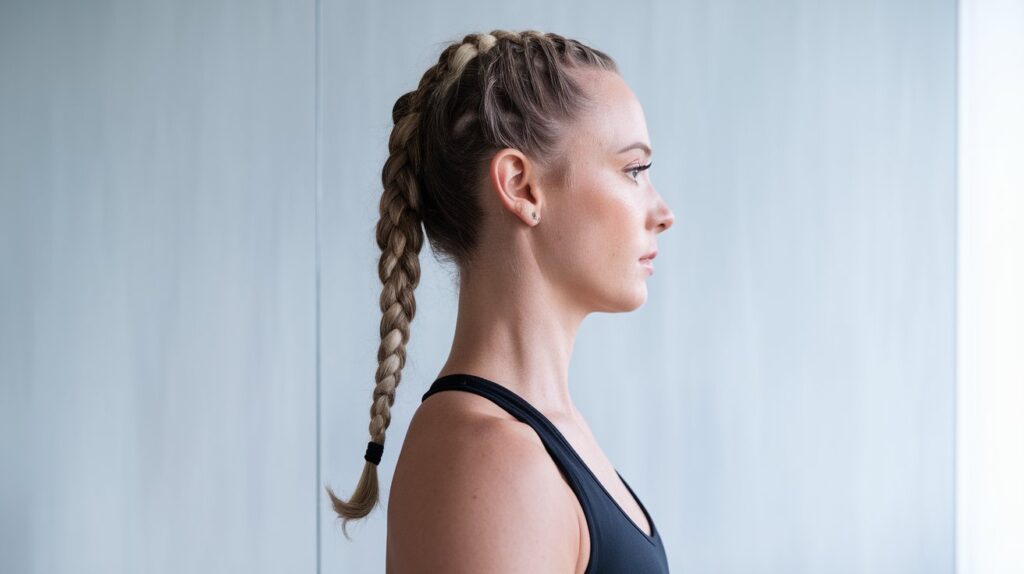
Selecting the right hairstyle for your Pilates session can transform your workout experience. The perfect style combines security with comfort, allowing you to focus entirely on your movements and breathing.
The Strategic Low Ponytail Technique
A low ponytail might seem basic, but its placement makes a significant difference during Pilates. Position the ponytail at the nape of your neck, slightly off-center. This strategic placement prevents discomfort when lying down while keeping hair contained during movements.
The success of this style depends on proper sectioning and securing. Start with smoothed-back hair, using a firm-hold gel on the crown. Double up on hair ties, placing them about half an inch apart to distribute tension and prevent slipping.
Here are the essential steps for a secure low ponytail:
- Brush hair thoroughly to remove tangles
- Apply a small amount of styling product for grip
- Gather hair at the nape, slightly off-center
- Secure with two hair ties
- Twist and pin any shorter layers
Ultra-High Top Knot Placement
The positioning of a top knot can make or break your Pilates practice. Place it right at the crown of your head, where it won’t interfere with mat work. This style works particularly well for longer sessions, as it keeps hair completely off your neck and face.
Creating a stable top knot requires more than just throwing your hair up. Start by gathering your hair into a high ponytail, then twist it around itself, securing with pins as you go. The key is to create a flat base that won’t wobble during inverted positions.
Secure Side Braid Methods
Side braids offer a practical solution for women who prefer their hair contained but find traditional updos too restrictive. A tight side braid, starting at the nape and angling slightly to one side, stays put during all types of movements.
The technique requires sectioning hair diagonally from the crown to behind the ear. This creates a natural flow that prevents the braid from pulling uncomfortably during different positions. Secure any shorter layers with small clips before braiding.
Modified French Braid Variations
A modified French braid provides maximum security with minimal bulk. Instead of braiding straight back, try creating two French braids that merge into one at the nape of your neck. This distribution of weight helps maintain comfort during rolling exercises.
The key to this style’s success lies in its tension. Begin with tight sections at the crown, gradually incorporating loose hair as you braid downward. This technique prevents the style from loosening during your workout while avoiding scalp strain.
Specialized Sport-Friendly Updos
Sport-friendly updos combine elements from multiple styles to create a secure solution for intense Pilates sessions. These styles typically involve multiple securing points and strategic pinning to maintain their shape throughout your practice.
One effective variation starts with a French twist at the back, secured with long pins, then tucks the remaining hair into a small bun at the crown. This hybrid style stays put during all types of movement while maintaining comfort in prone positions.
The most effective sport-friendly updos incorporate texture for extra grip. Using a light texturizing spray before styling helps prevent slipping and extends the style’s staying power throughout your session.
Your chosen style should feel secure yet comfortable from the first stretch to the final cool-down. Test different variations during your practice to find what works best with your hair type and length.
How Should You Adapt Your Hairstyle for Different Pilates Exercises?
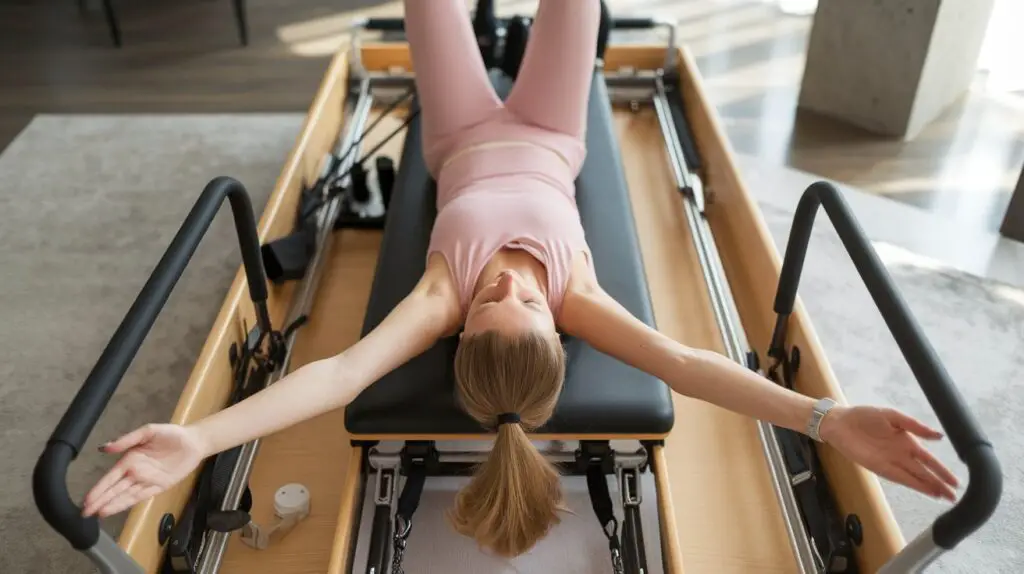
Different Pilates exercises require specific hair adjustments to maintain comfort and proper form. A style that works perfectly for one position might need modification for another, making adaptability essential for your workout routine.
Hairstyles for Supine Positions
Back-lying exercises demand careful consideration of hair placement. A low side braid proves particularly effective, as it can be easily shifted to prevent pressure points on the head. This positioning allows for smooth transitions while maintaining style integrity throughout your session.
For exercises like the Hundred or leg circles, try these proven solutions for back-lying comfort:
- Double French braids positioned slightly to the sides
- Low pigtails with soft hair ties
- Side-swept single braid
- Modified low bun
- Adjustable side ponytail
Solutions for Prone Exercises
Face-down positions present different challenges that require strategic styling. Two French braids starting at the crown and angling slightly backward work well for these movements. This technique keeps hair contained while distributing weight evenly across the head.
The key to successful prone exercise styling lies in creating a flat profile against the mat. A modified low ponytail, positioned just at the nape of the neck, allows for comfortable head placement without creating pressure points.
Styles that Work for Inversions
Inverted positions demand extra security to prevent hair from falling in your face. A high, tight bun might seem like the obvious choice, but its placement can create discomfort during certain movements. Instead, consider a hybrid style that combines security with comfort.
Two French braids that merge into one at the nape provide excellent stability for shoulder stands and other inverted positions. This style distributes weight evenly while keeping hair completely secure.
Hair Management During Rolling Movements
Rolling exercises require hair to move smoothly with your body. A single, well-placed braid can follow the natural curve of your spine during these movements. The key is positioning the style to avoid creating bumps or pressure points that might interfere with proper form.
Consider how your hair moves during each phase of rolling exercises. A style that stays put during the initial curl might shift during the extension phase, so test your chosen style through complete movement patterns.
Adjustable Styles for Flowing Sequences
Flowing sequences demand adaptable hairstyles that work in multiple positions. A modified side braid allows for quick adjustments between movements while maintaining overall style integrity. This versatility proves essential during dynamic sequences that combine various positions.
The placement of your hair ties makes a significant difference in style adaptability. Using smaller sections with multiple securing points creates a style that moves naturally with your body while staying contained.
Your chosen style should allow for smooth transitions between different positions. A well-planned hairstyle can significantly improve your focus and form during practice sessions.
Which Hair Accessories Work Best for Pilates?
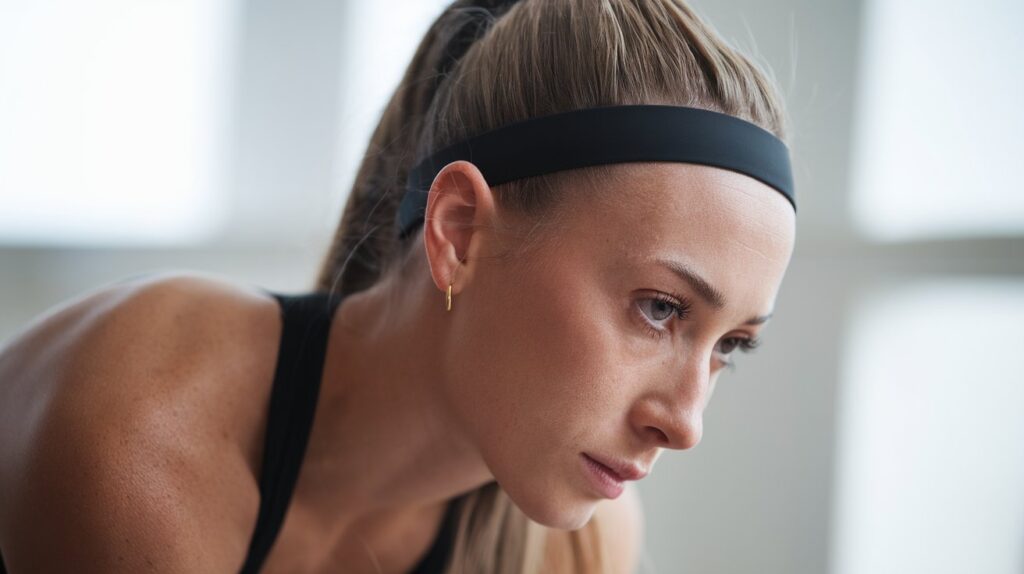
Selecting the right hair accessories can transform your Pilates practice from frustrating to focused. The proper tools keep your hair secure through every movement, allowing you to concentrate on your form.
Most Effective Hair Ties and Bands
Quality hair ties make a significant difference in your workout comfort. The best options for Pilates include spiral-style elastics that prevent creasing and provide gentle hold. These specialized ties distribute pressure evenly, reducing the risk of headaches during extended sessions.
Consider these proven options for maximum hold:
- Spiral elastics for crease-free security
- Soft ribbon ties for gentle grip
- Double-layer bands for thick hair
- No-slip silicon-lined elastics
- Seamless bands for sensitive scalps
Grip-Enhancing Products
A key factor in maintaining your style throughout class is using the right grip products. Dry shampoo applied to bobby pins creates extra hold without stickiness[3]. This simple trick prevents slipping during inverted positions and rolling movements.
Moisture-Wicking Headbands
Sweat management becomes crucial during intense sessions. Modern headbands feature specialized fabrics that pull moisture away from your face and hairline. The best options include those with cooling technology and UPF protection, offering multiple benefits during your workout.
Athletic headbands should sit comfortably without creating pressure points. Look for styles that stretch to accommodate different head sizes while maintaining their shape throughout multiple uses.
Bobby Pin Placement Techniques
Strategic bobby pin placement can make or break your hairstyle’s staying power. Position the wavy side down against your scalp for maximum grip. This technique creates a stronger hold that lasts through multiple exercises.
For shorter layers that tend to escape during movements, cross two pins in an X formation. This method provides extra security without visible bulk.
Secure Clip Options
Claw clips offer a versatile solution for quick style adjustments during transitions. Modern versions feature matte finishes and strong grips that work well for various hair textures[4]. These tools allow for easy repositioning between exercises without damaging your hair.
The positioning of clips matters significantly during mat work. Place them slightly off-center to avoid discomfort when lying down. This small adjustment prevents the clip from pressing into your head during floor exercises.
Your choice of hair accessories should support your practice, not distract from it. Testing different combinations of these tools helps create a reliable system that works for your specific needs.
How Can You Maintain Your Hairstyle Throughout Your Pilates Session?
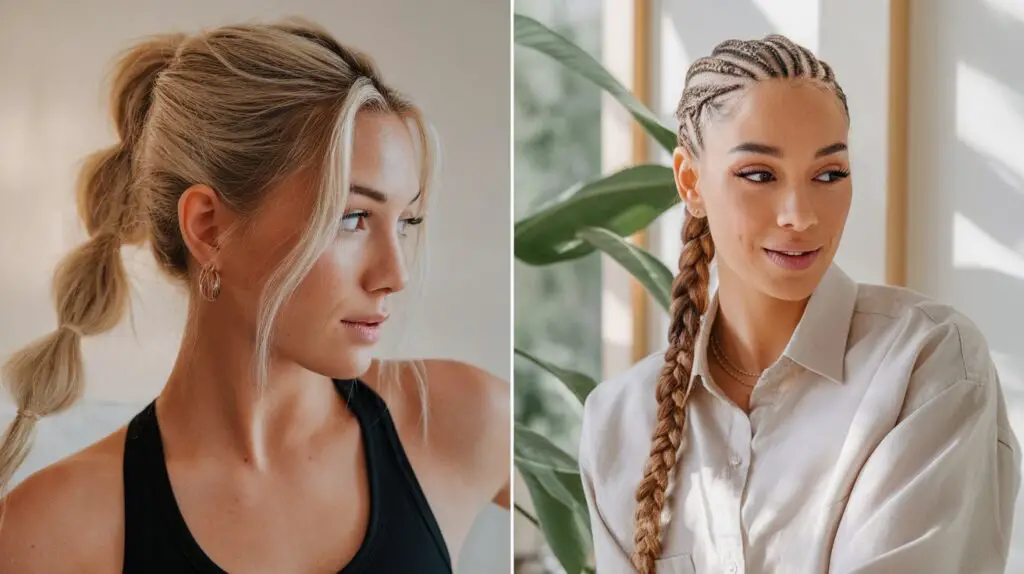
Maintaining your hairstyle during a Pilates session requires strategic planning and smart techniques. A few simple adjustments can help you stay focused on your workout instead of constantly fixing your hair.
Quick Adjustment Techniques
The key to quick fixes lies in preparation. Before starting your session, apply a light styling product to smooth flyaways. Keep a small pouch with essential hair tools within arm’s reach during your practice. These tools can help you make swift adjustments between exercises:
- Mini claw clips for temporary holds
- Bobby pins in matching hair color
- Soft elastic bands for backup
- Travel-size dry shampoo
- Small brush or comb
Securing Loose Strands Effectively
Short layers and baby hairs often escape during movements. Cross two bobby pins in an X formation near your temples to catch shorter pieces. For particularly stubborn sections, spray the pins with dry shampoo before inserting them – this creates extra grip without stickiness.
A double-securing method works well for longer hair. First, gather your hair into a low ponytail, then twist and pin sections separately. This technique distributes tension and prevents single points of pressure.
Sweat Management Strategies
Sweat can quickly undo even the most secure hairstyle. Start by applying a moisture-wicking product to your hairline before class. Position a thin headband slightly back from your hairline to catch sweat before it reaches your face or neck.
During intense sequences, pat your neck and hairline with a small towel between exercises. This prevents excess moisture from loosening your style or causing discomfort.
Style Longevity Tips
The placement of your hairstyle significantly affects its staying power. Position ponytails or buns slightly off-center to avoid direct contact with the mat. This small adjustment prevents friction that could loosen your style during floor work.
For longer sessions, consider starting with a tighter style that can gradually relax. A sleek braid or twisted bun might feel too tight initially but will settle into a comfortable position as you move through your workout.
Emergency Fix Solutions
Sometimes, despite careful planning, your hairstyle needs immediate attention. Keep a few emergency solutions ready. A quick spritz of water can help reshape and smooth unruly sections. For sudden flyaways, rub a small amount of lotion between your hands and smooth over the surface of your hair.
Side braids offer a quick solution when other styles fail. They can be quickly redone without requiring a full hairstyle reset, and they work well for most Pilates positions.
The right combination of preparation and quick fixes allows you to maintain your focus on the exercises rather than your hair. Small adjustments between movements help preserve your style while keeping you comfortable throughout your practice.
Perfect Hair, Perfect Practice
Your Pilates practice should focus on mindful movement and proper form, not constant hair adjustments. The right combination of hairstyles, accessories, and maintenance techniques creates a foundation for distraction-free sessions. From strategic styling to smart accessory choices, these methods help you stay present during your workout while maintaining both comfort and style.
A well-planned hair routine becomes second nature with practice. By selecting appropriate styles for different exercises, using the right tools, and mastering quick fixes, you can create a reliable system that works throughout your entire session. This attention to detail allows you to direct your energy where it matters most – achieving your fitness goals through focused, effective Pilates practice.
Frequently Asked Questions
Q: What’s the biggest mistake women make with their hair during Pilates?
A: Wearing a high ponytail during mat work, as it creates uncomfortable pressure points when lying down and can disrupt proper form.
Q: How can you prevent baby hairs from falling into your face during practice?
A: Apply dry shampoo to bobby pins and cross them in an X formation near the temples to secure shorter strands effectively.
Q: Which hair tie material works best for Pilates?
A: Spiral-style elastics are most effective as they distribute pressure evenly, prevent creasing, and reduce the risk of headaches during extended sessions.
Q: What’s the best hairstyle for inversion exercises?
A: Two French braids that merge into one at the nape provide optimal stability and comfort during shoulder stands and other inverted positions.
Q: How do you manage sweaty hair during intense Pilates sessions?
A: Apply a moisture-wicking product to your hairline before class and use a thin headband positioned slightly back from your hairline to catch sweat.
Q: What’s the quickest way to fix a failing hairstyle mid-session?
A: Switch to a side braid, as it can be quickly redone without requiring a complete hairstyle reset and works well for most Pilates positions.
Q: Where should you position a bun or ponytail for maximum comfort?
A: Slightly off-center to prevent direct contact with the mat, which reduces friction and helps maintain the style throughout your session.
Q: What essential hair accessories should you keep in your Pilates bag?
A: Mini claw clips, bobby pins in your hair color, soft elastic bands, travel-size dry shampoo, and a small brush or comb.

